
Knights of Labor, officially Noble and Holy Order of the Knights of Labor, was an American labor federation that was active in the late 19th century, especially the 1880s. It operated in the United States as well in Canada, and had chapters also in Great Britain and Australia. Its most important leader was Terence V. Powderly. The Knights of Labor promoted the social and cultural uplift of the worker, and demanded the eight-hour day. In some cases it acted as a labor union, negotiating with employers, but it was never well organized or funded. It was notable in its ambition to organize across lines of gender and race and in the inclusion of both skilled and unskilled labor. After a rapid expansion in the mid-1880s, it suddenly lost its new members and became a small operation again. The Knights of Labor had served, however, as the first mass organization of the white working class of the United States.

Carbondale is a city in Lackawanna County, Pennsylvania, United States. Carbondale is located approximately 15 miles due northeast of the city of Scranton in Northeastern Pennsylvania. The population was 8,828 at the 2020 census.

Scranton is a city in the Commonwealth of Pennsylvania, United States, and the county seat of Lackawanna County. With a population of 76,328 as of the 2020 U.S. census, Scranton is the largest city in Northeastern Pennsylvania and the Scranton–Wilkes-Barre–Hazleton Metropolitan Statistical Area, which has a population of 562,037 as of 2020. It is the sixth-largest city in Pennsylvania. The contiguous network of five cities and more than 40 boroughs all built in a straight line in Northeastern Pennsylvania's urban core act culturally and logistically as one continuous city, so while the city of Scranton itself is a mid-sized city, the larger Scranton/Wilkes-Barre Urban Area contains half a million residents in roughly 300 square miles. Scranton/Wilkes-Barre is the cultural and economic center of a region called Northeastern Pennsylvania, which is home to over 1.3 million residents.

Terence Vincent Powderly was an American labor union leader, politician and attorney, best known as head of the Knights of Labor in the late 1880s. Born in Carbondale, Pennsylvania, he was later elected mayor of Scranton, Pennsylvania, for three 2-year terms, starting in 1878. A Republican, he served as the United States Commissioner General of Immigration in 1897. The Knights of Labor was one of the largest white American labor organizations of the 19th century, but Powderly was a poor administrator and could barely keep it under control. His small central office could not supervise or coordinate the many strikes and other activities sponsored by union locals. Powderly believed that the Knights was an educational tool to uplift the white workingman, and he often cautioned against the use of strikes to achieve workers' goals.

The Delaware, Lackawanna and Western Railroad, also known as the DL&W or Lackawanna Railroad, was a U.S. Class 1 railroad that connected Buffalo, New York, and Hoboken, New Jersey, and by ferry with New York City, a distance of 395 miles (636 km). Incorporated in Pennsylvania in 1853 primarily for the purpose of providing a connection between the anthracite coal fields of Pennsylvania's Coal Region and the large markets for coal in New York City. The railroad gradually expanded both East and West, eventually linking Buffalo with New York City.
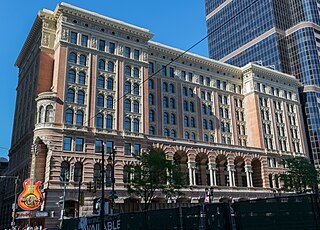
The Reading Terminal is a complex of buildings that includes the former Reading Company main station located in the Market East section of Center City in Philadelphia, Pennsylvania, United States. It comprises the Reading Terminal Headhouse, Trainshed, and Market.
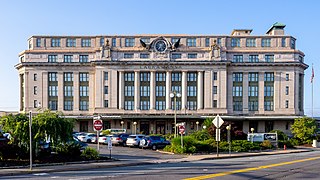
The Radisson Lackawanna Station Hotel, which was built as the Delaware, Lackawanna and Western Railroad Station, is a French Renaissance-style building in Scranton, Pennsylvania.
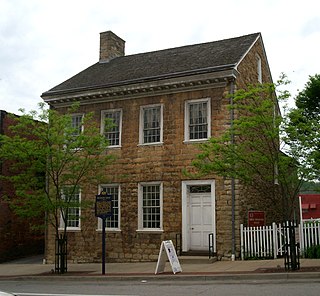
The David Bradford House is a historic house museum at 175 South Main Street in Washington, Pennsylvania. Completed in 1788, it was the home of David Bradford, a leader of the Whiskey Rebellion. It has both architectural and historic importance, and was designated a National Historic Landmark in 1983. It is open weekly between April and November, or by appointment.
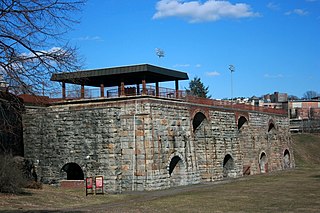
The Scranton Iron Furnaces is an historic, American manufacturing site that preserves the heritage of iron making in the U.S. State of Pennsylvania. It is located in Scranton, near the Steamtown National Historic Site.

The Robert Fulton Birthplace is a historic house museum at 1932 Robert Fulton Highway south of Quarryville, Pennsylvania. Built in the mid-18th century and reconstructed after a fire demolished it in 1822, it was the birthplace of inventor Robert Fulton (1765–1815). Fulton is best known for the development of commercially viable steamboats as a means of transportation. The house was declared a National Historic Landmark in 1964. The property is owned by the Southern Lancaster Historical Society which gives weekend tours of the house from Memorial Day through Labor Day.

The Tripp Family Homestead, also known as the "Tripp House", is an historic, American house that is located at 1101 N. Main Avenue in Scranton, Lackawanna County, Pennsylvania.
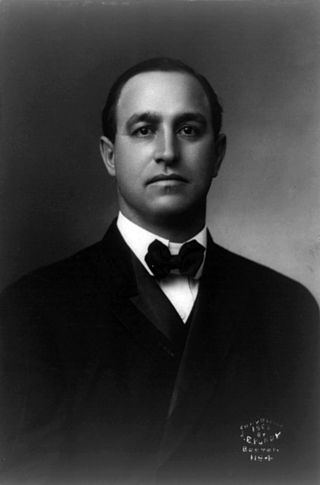
John Mitchell was a United States labor leader and president of the United Mine Workers of America from 1898 to 1908.

This is a list of the National Register of Historic Places listings in Lackawanna County, Pennsylvania.
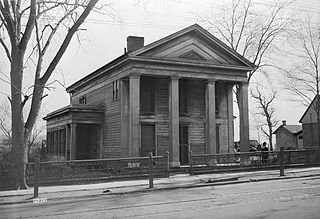
The Silkman House is located at 2006 Main Ave., Scranton, Lackawanna County, Pennsylvania. Even though it is popularly known as the Providence Branch of the Scranton Public Library, it is currently used as the technical services department of the Lackawanna County Library System and is no longer open to the public.

Lackawanna Avenue Commercial Historic District is a national historic district located in Scranton, Lackawanna County, Pennsylvania. It encompasses 69 contributing buildings in a variety of architectural styles, including Late Victorian, Classical Revival, and Art Deco. The buildings are mostly three to four stories in height and three to five bays wide. Located in the district and separately listed is the Dime Bank Building.

Delaware, Lackawanna and Western Railroad Yard-Dickson Manufacturing Co. Site is a national historic district located in Scranton, Lackawanna County, Pennsylvania. It encompasses the Steamtown National Historic Site and Scranton Army Ammunition Plant and includes 16 contributing buildings, four contributing sites, and five contributing structures. The yard includes buildings and structures related to the yard's expansion in 1899-1939, and its usage as steam locomotive maintenance complex. The Dickson Manufacturing Company built steam locomotives, and the site of its works are included in this district.

Roaring Brook is a tributary of the Lackawanna River in Lackawanna County, Pennsylvania, in the United States. It is approximately 21 miles (34 km) long and flows through Covington Township, Madison Township, Moscow, Roaring Brook Township, Elmhurst Township, Dunmore, and Scranton. The watershed of the stream has an area of 56.3 square miles (146 km2). Its named tributaries include Little Roaring Brook, Rock Bottom Creek, White Oak Run, Van Brunt Creek, Bear Brook, and East Branch Roaring Brook. It has a high level of water quality for much of its length. However, it is affected by abandoned mining land, stormwater, and other impacts in its lower reaches. Reservoirs in the watershed include the Hollister Reservoir, the Elmhurst Reservoir, and others. The stream also flows through the Nay Aug Gorge and passes over the Nay Aug Falls, which are on the National Register of Geologic Landmarks. It flows through a concrete channel in its lower reaches. The topography of the watershed contains rolling hills in its upper reaches and the mountainous land of the Moosic Mountains in its lower reaches.

The Scranton general strike was a widespread work stoppage in 1877 by workers in Scranton, Pennsylvania, which took place as part of the Great Railroad Strike, and was the last in a number of violent outbreaks across Pennsylvania. The strike began on July 23 when railroad workers walked off the job in protest of recent wage cuts, and within three days it grew to include perhaps thousands of workers from a variety of industries.
Robert Hayworth McKune was an American businessman and politician, elected as mayor of Scranton, Pennsylvania, serving 1876 through 1878.




















